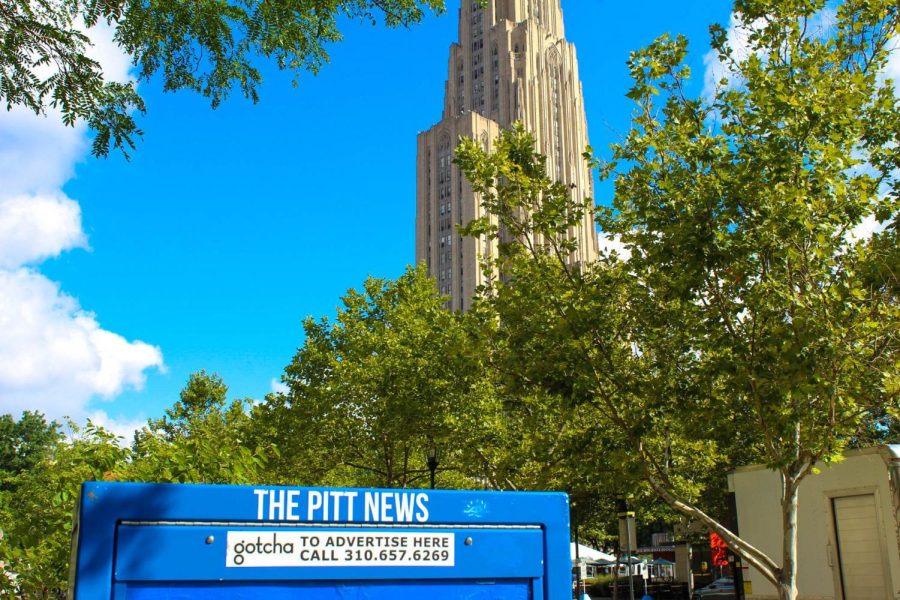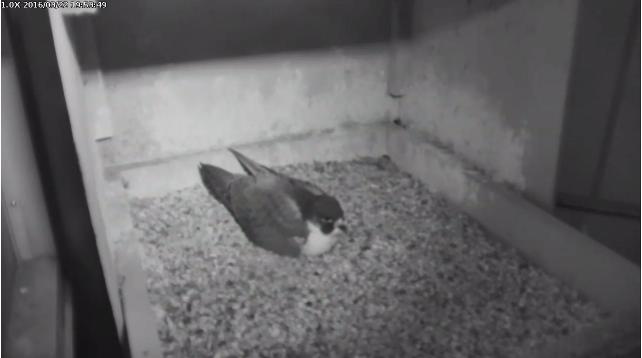A little more than three months after his first partner fell from the sky — and three days after his current partner laid her first egg — the paternal half of Pitt’s peregrine falcon couple has passed away.
E2, the peregrine falcon who last semester occupied a nest on a ledge of the Cathedral of Learning with Dorothy, his late peregrine falcon partner, died in Friendship last week. A passerby outside a yard in Friendship found a dead falcon last Wednesday, which the National Aviary confirmed was E2. Based on the injuries to his right wing and leg, Kate St. John, a Pittsburgh birdwatcher who runs a blog called “Outside My Window” about Pitt’s falcons and other birds, said she believes a car accidentally hit E2 broadside.
“When peregrine hunt, they swoop down on their prey,” St. John, who is also a former WQED director of information technology, said. “So in this case, the bird must have dodged and flown low over the road.”
For bird watchers, E2’s death is another loss of majestic life. But now, they are more concerned about E2’s partner and fledglings, or offspring, and making sure the Cathedral doesn’t lose all of its falcons. Hope, E2’s current partner, laid her first egg of 2016 last Sunday. Currently still residing at the Cathedral, Hope has now laid a total of three eggs this season.
According to the U.S. Fish and Wildlife Service, peregrine falcons are an endangered species with only 2,000 to 3,000 breeding pairs living across North America. About 40 breeding pairs lived in Pennsylvania as of 2013, according to the Pennsylvania Game Commission. The falcons are most concentrated near Philadelphia and Pennsylvania’s Delaware border, and prefer to nest on cliffs and high ledges.
In December, the 15-year matriarch of the Cathedral, Dorothy, disappeared from the area and is now presumed dead. For those who followed Dorothy’s life, her death made sense — she was a remarkable 17 years old. The typical lifespan for peregrines in the wild is a little over 10 years. But whether E2’s death was by car or old age, he too was advancing in age at 11 years old.
A death like E2’s, however, is more common in juvenile peregrines, according to Peter Bell, a Pitt chemistry professor and creator of a Facebook fan page for Pitt’s falcons.
“Accidents like these are remarkably common since peregrines have integrated into the urban environment. Two-thirds of juveniles die before they reach adulthood,” Bell said.
Young peregrines are known to have a particularly high mortality rate, according to the Raptor Research Project, but can live for a relatively long time in the wild.
E2’s death means Hope will not have help keeping the eggs warm, which is necessary for them to hatch. During the incubation period, one of the adults — usually the male adult — must always keep the eggs warm. In the time that it would take Hope to catch and eat food, her eggs would become inviolable, and peregrines know that they cannot incubate eggs on their own.
St. John points out in her blog that now is not the time to be sad. Although risking the death of her current eggs, Hope, and other single peregrines, still have time to find a new mate this season if they hurry.
“Peregrines don’t grieve, especially in March when their hormones are driving them to reproduce,” St. John said. “Between now and September they must defend a territory, mate, lay eggs and raise young to self-sufficiency.There is still time for Hope to raise a family if she finds a mate soon.”
Hope should have no shortage of suitors at this time of the year, with unattached male peregrines looking to find mates and a nest before the mating season is over.
“Every peregrine population has a certain number of ‘floaters,’ which are birds that do not have a mate or a territory, but are looking around for a chance to find territory and mate,” Art McMorris, the Pennsylvania Game Commission’s peregrine falcon coordinator, said in an email.
The Cathedral would make a good home for these floaters, according to McMorris, so Hope likely will not go too long without a mate.
Hope’s best case scenario, according to St. John, would be to find a mate before the end of April. If she does, they could still lay eggs together and have baby falcons this year, St. John said.
“I just want to see two falcons excited to meet each other and ready to lay eggs before it’s too late,” St. John said.
Even with the loss of another peregrine falcon, many bird watchers are optimistic. Bird watchers hope that the death is one more episode in the peregrine saga that will eventually lead to a thriving falcon family atop the Cathedral again.
“If they die, it’s in a fight or getting hit,” St. John said. “Whatever they do, peregrines live fast.”



